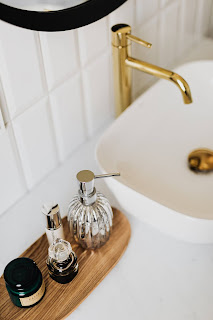The Healthy Home - The Bathroom
How many products do you use every morning before leaving the house?
Are there expired products that can be thrown away?
Exploring the Bathroom
There is nothing like getting ready for our day consuming nitrosamines, lead, heavy metals, parabens, formaldehyde, phthalates, and hydroquinone. We are ingesting poison with all the cosmetics, skin-care treatments, perfume, antiperspirants, shampoos, conditioners, lipsticks, powders, toothpaste, sunscreen, nail polish and other personal products that we use each day in our bathroom. Yikes!
Are there expired products that can be thrown away?
Exploring the Bathroom
There is nothing like getting ready for our day consuming nitrosamines, lead, heavy metals, parabens, formaldehyde, phthalates, and hydroquinone. We are ingesting poison with all the cosmetics, skin-care treatments, perfume, antiperspirants, shampoos, conditioners, lipsticks, powders, toothpaste, sunscreen, nail polish and other personal products that we use each day in our bathroom. Yikes!
Deodorant
Most deodorants contain aluminum
chlorohydrate or aluminum zirconium. These compounds have been linked to breast
cancer, kidney failure, Alzheimer’s and Parkinson’s disease. They're also found
in buffered aspirin, antacids, and digestive aids. If you
are deficient in magnesium, calcium or iron, aluminum will actually displace
these minerals needed for enzyme processes inside your cells. Ingesting lemon
juice, kelp or turmeric can help cleanse it from your brain too.
Toothpaste
We all want a nice smile and fresh breath? Did
you know the fluoride found in toothpaste and in some water supplies is actually
industrial waste that has been repackaged? The physical action of brushing,
along with flossing, is what really cleans our teeth, not the fluoride itself.
Mouthwash contains varying levels of phenol, cresol, ethanol, formaldehyde and
ammonia. Minty but toxic.
Mercury
Mercury, the most toxic nonradioactive
metal on the planet, has been used for decades in dental fillings. Chewing or
drinking hot liquids creates mercury vapours absorbed into the body. Mercury can
poison and kill cells. It has a high affinity for nerve cells and readily
enters the brain resulting in nervous, digestive and immune problems.
Vaccines
Vaccines aren’t found in the bathroom but they’re in most of us. Prior to
1989 preschoolers received eleven vaccinations from such diseases as polio,
measles, mumps and rubella. Today it is not uncommon for children to receive as
many as fifty doses of vaccines. What’s in the vaccines? Preservatives.
Preservatives that may contain forms of mercury that have been scrutinized and
is still being questioned to contribute to neurological disorders.
Medicine
Cabinet
A location medication (antibiotics), antibacterial
items and skincare products are stored.
 Antibiotics fight
bacterial infections but do nothing to help cure viral infections (such as the
common cold or flu). Extended use has made every major type of bacterial
infection less responsive to antibiotic treatment.
Antibiotics fight
bacterial infections but do nothing to help cure viral infections (such as the
common cold or flu). Extended use has made every major type of bacterial
infection less responsive to antibiotic treatment.
Antibacterial products
containing triclosan, which is considered a pesticide, is everywhere.
Triclosan can inhibit the immune system.
Pain relievers allow us to
do things we really shouldn’t like drinking too much alcohol, eating too
close to bedtime, over-exerting ourselves, or simply having a bad diet. Why not
simply make a few lifestyle changes?
Take precautions on how much and how often
these are used.
Conclusion
Toxins we encounter in the
bathroom may affect our bodies in short and long term health. Reducing your exposure to even some of these
chemicals will make a major difference over a lifetime.
Are there some products that can be replaced with safer choices?
Can I reduce the number of products I use every day?
Are there some products that can be replaced with safer choices?
Can I reduce the number of products I use every day?
Sources: The Healthy Home by Dr. Myron Wentz & Dave Wentz
If you have missed any of the articles in our series or our videos not to worry click below:
The Bedroom: Blog Video
The Bathroom: Video
The Kitchen: Blog Video
Living Areas: Blog Video
Garage & Yard: Blog Video
The Healthy Way Vibes – Health Warriors
Please comment below, like, and share



Comments
Post a Comment